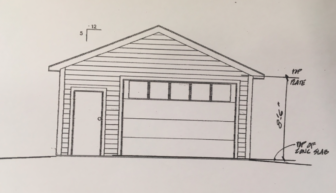Months after town officials issued a Knapp Lane resident a fine and cease-and-desist order following multiple violations of state laws, building codes and environmental regulations for work done in and near a pond and brooks on the 1.84-property, an architect representing the homeowner is seeking after-the-fact approval for a storage shed located well within a setback area.

Evidence of violations of wetlands, building and P&Z regulations at 109 Knapp Lane in New Canaan. Department of Land Use photo
Discovered by chance by municipal officials in January, the freestanding shed at 109 Knapp Lane had been built with no permits—a structure that had stood there also was demolished with no town approvals—and sits less than nine feet from the property line, in lieu of the 25 feet required for side yard setbacks in the 1-acre zone (see page 58 here).
Even so, according to Elmsford, N.Y.-based Escaladas Architects, the 20-by-24-foot shed with a permanent concrete foundation was built just there since that spot “represents the highest elevation of the rear portion of the lot, and therefore, provided the greatest protection from historical flooding experienced in the area.”
“Building the structure in a different place than the originally chosen one, as depicted in the site plan 100-year flood line delineation, would have placed the structure directly in a flood plain and would represent the wrong choice for user and neighbors, since the filling in a flood plain is detrimental to all,” Escaladas said in a letter to the Zoning Board of Appeals.

A rendering of the new storage shed, already installed, at 109 Knapp Lane.
“Perhaps a hidden benefit to this action is the fact that the re-contouring of the land has cleaned up the old debris and fallen trees. The elimination of this volume has added flood volume to the area. As can be seen by the location of the 100-year flood line, before this action, it was stopped by a higher topographical barrier (pre existing elevations). The resulting sculpting of the area immediately behind and around the new structure has removed (re-contoured) the pre-existing topography, creating a ‘new’ lower and wider flatter and lower area than before, in essence creating additional flood receptive ‘storage of volume.’ ”
The ZBA is scheduled to hear the matter at its regular meeting at 7 p.m. Tuesday.
Demolition of the former shed and construction of the new one were two of several projects undertaken without required permissions at the Knapp Lane property, according to the town. Others include driving construction equipment through a watercourse, removing trees, brush and undergrowth, excavating soil, constructing a bridge and wall of boulders, and installing a concrete slab.
The town on discovering the activities issued a Municipal Citation as well as a stop work order and notice of violation. The owner was cited for violating a state law that deals with permits required prior to demolition, three sections of the Connecticut State Building Code, multiple parts of two sections in New Canaan’s Inland Wetlands Regulations and five sections in the town’s Zoning Regulations, officials have said.
The extent of Escaladas’ involvement in the overall project is unclear.
The architect in the letter to ZBA said that by installing the shed where he did the area now has “increased the storage volume” in terms of flooding.
“The creation of a new lower plain behind and around the new structure will bring better results to the area than before this action,” the letter said.
“It can also be said that the action taken has not created any negative impacts to the immediate vicinity. The elimination of the damaged, leaning structure has been an aesthetic improvement to the area. All neighbors are welcoming the reconstruction of the older structure with a new one. The location of the ancillary structure is also furthest away from the water’s edge of the pond. Any possible future erosion is further away from the water’s productive biological and vegetative edge.”